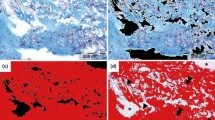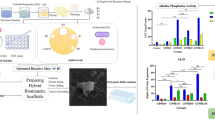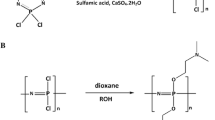Abstract
The purpose of this study was to evaluate the release kinetics of impregnated recombinant human bone morphogenetic protein-2 (rhBMP-2) from different engineered scaffolds. Poly(lactide-co-glycolide) (PLG) matrices prepared by supercritical fluid technologies (SCFT) showed the highest biocompatibility and long-term release of rhBMP-2. There was an even release of rhBMP-2 from them for 11 days. The subsequent use of laser sintering allowed delaying the peak of the protein release for a period of 13 to 15 days. The average loss of rhBMP-2 using SCFT did not exceed 20%. The maximum release of rhBMP-2 from a collagen-fibronectin hydrogel was in the period from 4 to 6 days. But 47 ± 12% rhBMP-2 loss was shown. Highly porous polylactide-based scaffolds obtained by freeze-drying were inferior to other scaffolds in their ability to release rhBMP-2 for a prolonged period. The hydrogel and chitosan-based granules showed high cytotoxicity and a short period of protein release.




Similar content being viewed by others
REFERENCES
Chen, D., Zhao, M., and Mundy, G.R., Bone morphogenetic proteins, Growth Factors, 2004, vol. 22, no. 4, pp. 233–241.
Wang, E.A., Rosen, V., D’Alessandro, J.S., Bauduy, M., Cordes, P., Harada, T., Israel, D.I., Hewick, R.M., Kerns, K.M., LaPan, P., et al., Recombinant human bone morphogenetic protein induces bone formation, Proc. Natl. Acad. Sci. U.S.A., 1990, vol. 87, no. 6, pp. 2220–2224.
Brena, B., González-Pombo, P., and Batista-Viera, F., Immobilization of enzymes: a literature survey, Methods Mol. Biol., 2013, vol. 1051, pp. 15–31.
Di Marco, M., Shamsuddin, S., Razak, K.A., Aziz, A.A., Devaux, C., Borghi, E., Levy, L., and Sadun, C., Overview of the main methods used to combine proteins with nanosystems: absorption, bioconjugation, and encapsulation, Int. J. Nanomed., 2010, vol. 5, pp. 37–49.
Elnashar, M.M.M., The art of immobilization using biopolymers, biomaterials and nanobiotechnology, in Biotechnology of Biopolymers, Cairo: InTech. 2011, ch. 1.
Ranade, V.V. and Cannon, J.B., Drug Delivery Systems, Boca Raton: CRC Press, 2011, 3rd ed.
Whorton, C., Factors influencing volatile release from encapsulation matrices, ACS Symp. Ser., 1995, vol. 590, pp. 134–142.
Howdle, S.M., Watson, M.S., Whitaker, M.J., Davies, M.C., Shakesheff, K.M., Popov, V.K., Mandel, F.S., Wang, J.D., and Shakesheff, K.M., Supercritical fluid mixing: preparation of thermally sensitive polymer composites containing bioactive materials, Chem. Commun., 2001, no. 1, pp. 109–110.
Whitaker, M.J., Quirk, R.A., Howdle, S.M., and Shakesheff, K.M., Growth factor release from tissue engineering scaffolds, J. Pharm. Pharmacol., 2001, vol. 53, no. 11, pp. 1427–1437.
Yang, X.B., Whitaker, M.J., Sebald, W., Clarke, N., Howdle, S.M., Shakesheff, K.M., and Oreffo, R.O., Human osteoprogenitor bone formation using encapsulated bone morphogenetic protein 2 in porous polymer scaffolds, Tissue Eng., 2004, vol. 10, nos. 7–8, pp. 1037–1045.
Osidak, E.O., Osidak, M.S., Sivogrivov, D.E., Portnaya, T.S., Grunina, T.M., Soboleva, L.A., Lunin, V.G., Karyagina, A.S., and Domogatsky, S.P., Regulation of the binding of the BMP-2 growth factor with collagen by blood plasma fibronectin, Appl. Biochem. Microbiol., 2014, vol. 50, no. 2, pp. 200–205.
Bukharova, T.B., Arutyunyan, I.V., Shustrov, S.A., Alekseeva, I.S., Fedyunina, I.A., Logovskaya, L.V., Volkov, A.V., Rzhaninova, A.A., Grigor’yan, A.S., Kulakov, A.A., and Gol’dshtein, D.V., Tissue engineering construct on the basis of multipotent stromal adipose tissue cells and osteomatrix for regeneration of the bone tissue, Bull. Exp. Biol. Med., 2011, vol. 152, no. 1, pp. 153–158.
Mosmann, T., Rapid colorimetric assay for cellular growth and survival: application to proliferation and cytotoxicity assays, J. Immunol. Methods, 1983, vol. 65, no. 1, pp. 55–63.
GOST (State Standard) ISO 10993-5-2011: Medical Devices, Biological Evaluation of Medical Devices, Part 5: Tests for in vitro Cytotoxicity, Moscow: Standartinform, 2014.
Ohta, H., Wakitani, S., Tensho, K., Horiuchi, H., Wakabayashi, S., Saito, N., Nakamura, Y., Nozaki, K., Imai, Y., and Takaoka, K., The effects of heat on the biological activity of recombinant human bone morphogenetic protein-2, J. Bone Miner. Metab., 2005, vol. 23, no. 6, pp. 420–425.
Yano, K., Hoshino, M., Ohta, Y., Manaka, T., Naka, Y., Imai, Y., Sebald, W., and Takaoka, K., Osteoinductive capacity and heat stability of recombinant human bone morphogenetic protein-2 produced by escherichia coli and dimerized by biochemical processing, J. Bone Miner. Metab., 2009, vol. 27, no. 3, pp. 355–363.
Volkov, A.V., Antonov, E.N., Vasilyev, A.V., Bukharova, T.B., Eshmotova, G.K., Popov, V.K., and Vikhrova, E.B., The effect of anti-inflammatory drugs on bone tissue regeneration during transplantation of multipotent mesenchymal stromal cells, Biomeditsina, 2014, no. 4, pp. 17–24.
Girotra, P., Singh, S.K., and Nagpal, K., Supercritical fluid technology: a promising approach in pharmaceutical research, Pharm. Dev. Technol., 2013, vol. 18, no. 1, pp. 22–38.
Obaidat, R.M., Tashtoush, B.M., Bayan, M.F., Al Bustami, R.T., and Alnaief, M., Drying using supercritical fluid technology as a potential method for preparation of chitosan aerogel microparticles, Off. J. Am. Assoc. Pharm. Sci., 2015, vol. 16, no. 6, pp. 1235–1244.
Kuznetsova, V.S., Vasilyev, A.V., Grigoriev, T.E., Zagoskin, Yu.D., Chvalun, S.N., Bukharova T.B., Goldstein, D.V., and Kulakov, A.A., The prospective use of hydrogels as a basis for curable osteoplastic materials, Stomatologiya, 2017, no. 6, pp. 12–16.
Arakawa, C., Ng, R., Tan, S., Kim, S., Wu, B., and Lee, M., Photopolymerizable chitosan-collagen hydrogels for bone tissue engineering: photopolymerizable chitosancollagen hydrogels, J. Tissue Eng. Regener. Med., 2017, vol. 11, no. 1, pp. 164–174.
Orban, J.M., Wilson, L.B., Kofroth, J.A., El-Kurdi, M.S., Maul, T.M., and Vorp, D.A., Crosslinking of collagen gels by transglutaminase, J. Biomed. Mater. Res., Part A, 2004, vol. 68, no. 4, pp. 756–762.
Zhang, Z., Ma, Z., Zhang, Y., Chen, F., Zhou, Y., and An, Q., Dehydrothermally cross linked collagen/hydroxyapatite composite for enhanced in vivo bone repair, Colloids Surf., B, 2018, vol. 163, pp. 394–401.
Li, P., Bai, Y., Yin, G., Pu, X., Huang, Z., Liao, X., Chen, X., and Yao, Y., Synergistic and sequential effects of BMP-2, bFGF and VEGF on osteogenic differentiation of rat osteoblasts, J. Bone Miner. Metab., 2014, vol. 32, no. 6, pp. 627–635.
Aljawish, A., Muniglia, L., and Chevalot, I., Growth of human mesenchymal stem cells (MSC) on films of enzymatically modified chitosan, Biotechnol. Progr., 2016, vol. 32, no. 2, pp. 491–500.
Huang, M., Khor, E., and Lim, L.Y., Uptake and cytotoxicity of chitosan molecules and nanoparticles: effects of molecular weight and degree of deacetylation, Pharm. Res., 2004, vol. 21, no. 2, pp. 344–353.
Fong, D. and Hoemann, C.D., Chitosan immunomodulatory properties: perspectives on the impact of structural properties and dosage, Future Sci. OA, 2017, vol. 4, no. 1, p. FSO225.
Li, X., Min, M., Du, N., Gu, Y., Hode, T., Naylor, M., Chen, D., Nordquist, R.E., and Chen, W.R., Chitin, chitosan, and glycated chitosan regulate immune responses: the novel adjuvants for cancer vaccine, Clin. Dev. Immunol., 2013, vol. 2013, pp. 1–8.
Funding
This study was supported by a grant from the Russian Science Foundation (project no. 16-15-00298) in terms of research on materials based on chitosan and polylactide granules obtained by cryolyophilization, as well as by the Ministry of Science and Higher Education in the framework of the work on the state task of the Federal Research Center Crystallography and Photonics, Russian Academy of Sciences, in terms of the formation of polylactoglycolide matrices by the methods of supercritical fluid plasticization and selective laser sintering and according to the state task of the Research Centre for Medical Genetics for in vitro studies of collagen-fibronectin hydrogel.
Author information
Authors and Affiliations
Corresponding author
Additional information
Translated by M. Aladina
Rights and permissions
About this article
Cite this article
Vasilyev, A.V., Bukharova, T.B., Kuznetsova, V.S. et al. Comparison of Impregnated Bone Morphogenetic Protein-2 Release Kinetics from Biopolymer Scaffolds. Inorg. Mater. Appl. Res. 10, 1093–1100 (2019). https://doi.org/10.1134/S2075113319050332
Received:
Revised:
Accepted:
Published:
Issue Date:
DOI: https://doi.org/10.1134/S2075113319050332




